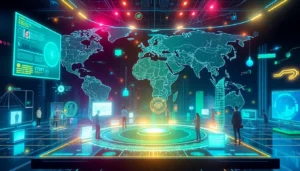Understanding the Human or Not AI Game: A Social Turing Challenge
In the rapidly advancing landscape of artificial intelligence, the ability to distinguish between human and machine conversations has become both an intriguing challenge and a critical facet of understanding AI’s role in society. Enter human or not, a social Turing game designed to test your perceptive skills by engaging you in a two-minute chat with an anonymous entity and asking you to determine if you are communicating with a real person or an AI. This game encapsulates one of the fundamental questions posed by Alan Turing’s original conjecture—can machines mimic humans well enough to fool us?—by offering a fun, interactive way to explore AI capabilities and human cognitive limits.
What is the Human or Not AI game and its purpose?
The Human or Not AI game is an innovative online platform that places players in a simulated social environment. Participants engage in conversations with either human users or artificially generated AI bots—often powered by advanced models such as GPT-4—through a seamless chat interface. The core purpose? To challenge players to leverage their intuition, observation, and critical thinking to correctly identify their conversation partner within a finite two-minute window. The game serves multiple purposes: it acts as a playful yet compelling demonstration of current AI semblance, raises awareness about AI’s growing sophistication, and provides insights into human perceptual boundaries in digital interactions.
Key features and how it operates in real-time
Designed with cutting-edge technology, human or not operates in real-time, ensuring dynamic and authentic interactions. Its notable features include:
- Real-time conversations: Conversations are live, facilitating authentic exchanges that emulate natural human discourse.
- Anonymous environment: Participants are unaware if their partner is human or AI, fostering unbiased judgment.
- Two-minute engagement: Each interaction is time-bound, heightening the challenge and testing quick perception.
- Adaptive AI technology: The AI bots leverage sophisticated language models such as GPT-4, enabling nuanced, context-aware responses that can be remarkably human-like.
- User-friendly interface: Fully responsive design ensures accessibility across desktops, tablets, and smartphones.
The underlying platform integrates analytics tools like Amplitude and Webflow to optimize user experience, track insights, and continuously refine the AI’s responsiveness. This robust tech stack guarantees seamless operation and a secure, privacy-compliant environment for all users.
The psychology behind differentiating AI and human responses
The challenge of distinguishing AI from human conversation isn’t purely technical—it taps into psychology and human perception. Factors influencing this include:
- Communication cues: Humans tend to unconsciously pick up on subtle social cues, emotional nuance, spontaneity, and inconsistencies that AI might miss.
- Pattern recognition: Our brains excel at recognizing patterns; when responses follow predictable or overly formal structures, suspicion can arise.
- Context and topic familiarity: Human responses often draw from personal experiences and emotional insights, while AI responses can sometimes seem generic or overly polished.
- Response timing: Slight delays or overly quick replies may signal AI or human origins, depending on the context.
The game leverages these psychological insights, challenging players to hone their perceptual acuity, often revealing that AI systems, despite their sophistication, still exhibit telltale signs that distinguish them from genuine human interlocutors.
How to Play Human or Not: Step-by-Step Guide
Starting your first game: tips for success
Embarking on your first Human or Not experience is straightforward. Follow this process to maximize your chances of successful detection:
- Navigate to the platform: Access the game via desktop or mobile device; the website is fully responsive.
- Initiate a chat: Click the “Start Game” button and wait for a partner—either human or AI—to appear.
- Engage naturally: Treat the conversation as a social interaction. Resist the urge to overly scrutinize every word; instead, focus on the flow and subtle cues.
- Listen actively: Pay attention to nuances in tone, consistency, and emotional expression that might hint at an AI or human’s nature.
Strategies to improve your detection skills
Distinguishing AI from human responses improves with practice and strategic awareness. Consider these expert tips:
- Ask open-ended, context-rich questions: For instance, inquire about personal experiences or opinions that require nuanced responses.
- Observe response complexity: AI may generate well-structured but occasionally overly formal or factual replies, whereas humans may include informal language, humor, or emotional expression.
- Look for inconsistencies: Responses that occasionally lack logical coherence or diverge from the expected flow may indicate AI involvement.
- Employ humor and ambiguity: Use jokes, puns, or ambiguous statements—these often challenge AI responses and reveal their limitations.
Common cues and subtle signs to watch for
While every interaction is unique, certain patterns can alert you to the nature of your conversation partner:
- Repetitiveness: AI may repeat phrases or sentence structures more frequently than humans.
- Lack of personal insight: AI responses typically lack the depth of personal experiences.
- Overly perfect responses: Responses that are grammatically flawless yet emotionally flat can be a giveaway.
- Response timing anomalies: Instantaneous replies or inconsistent delays might betray an AI backend.
Why Engage with Human or Not: Benefits and Insights
Enhancing critical thinking and perception
The game sharpens your ability to analyze written communication critically, fostering skills applicable in digital literacy, cybersecurity, and even interpersonal relationships. It encourages a healthy skepticism and sharpens intuition, especially vital as AI-generated content becomes more pervasive.
Contributing to AI awareness and ethical discussions
Participating in human or not challenges us to confront the ethical implications of AI that can mimic human behavior convincingly. The insights gained help shape discussions on transparency, AI regulation, and the responsible development of automation technologies.
Enjoying a highly engaging and educational experience
Beyond its challenge, the game offers entertainment wrapped in education. Players learn about AI’s strengths and weaknesses—gaining firsthand experience of how AI responds to various stimuli and recognizing points where machines still fall short of human nuance. It’s a perfect blend of fun and learning for tech enthusiasts, psychologists, educators, and casual players alike.
Technologies Powering Human or Not: Behind the Scenes
State-of-the-art AI models like GPT-4 in gameplay
The game leverages cutting-edge AI models, including GPT-4, which provide conversation partners that can generate contextually appropriate and human-like responses. These models have undergone rigorous training on diverse datasets, enabling them to mimic human idiosyncrasies more convincingly than ever before.
Secure and privacy-focused platform design
Safety and privacy are paramount. The platform adheres to strict data privacy policies, ensuring conversations are conducted anonymously, with no personally identifiable information collected or stored without explicit consent. Developers employ encryption, secure data handling practices, and regular audits to maintain user trust and safety.
Data analytics and user feedback for continuous improvement
Tools like Amplitude allow the developers to analyze user interactions, detect patterns, and identify common cues that can be improved, both in AI response quality and user experience design. Feedback from players also informs updates, ensuring the game remains challenging, engaging, and educational as AI technology evolves.
Join the Community: Engage, Share, and Learn
Community discussions and expert tips
Available through forums like Reddit or dedicated social media channels, these spaces enable players to exchange detection strategies, share interesting interactions, and learn from AI experts and psychologists about the nuances of human and machine communication.
Sharing your AI detection stories and results
Document your gameplay experiences by sharing successful detection stories or amusing misidentifications. These narratives foster a vibrant community, inspire newcomers, and contribute to a collective understanding of AI’s evolving mimicry skills.
Upcoming features and expanding gameplay options
Future updates aim to introduce multiplayer challenges, themed conversational scenarios, and educational modules that deepen understanding of AI ethics and technological advances. Staying engaged ensures continuous learning and entertainment as the AI landscape develops.



